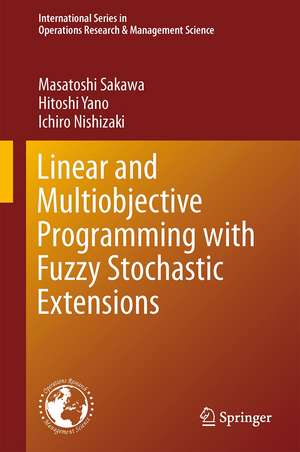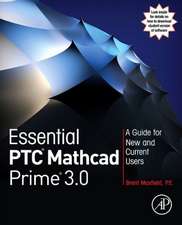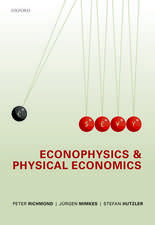Linear and Multiobjective Programming with Fuzzy Stochastic Extensions: International Series in Operations Research & Management Science, cartea 203
Autor Masatoshi Sakawa, Hitoshi Yano, Ichiro Nishizakien Limba Engleză Hardback – 29 noi 2013
Organization of each chapter is briefly summarized as follows: Chapter 2 is a concise and condensed description of the theory of linear programming and its algorithms. Chapter 3 discusses fundamental notions and methods of multiobjective linear programming and concludes with interactive multiobjective linear programming. In Chapter 4, starting with clear explanations of fuzzy linear programming and fuzzy multiobjective linear programming, interactive fuzzy multiobjective linear programming is presented. Chapter 5 gives detailed explanations of fundamental notions and methods of stochastic programming including two-stage programming and chance constrained programming. Chapter 6 develops several interactive fuzzy programming approaches to multiobjective stochastic programming problems. Applications to purchase and transportation planning for food retailing are considered in Chapter 7.
The book is self-contained because of the three appendices and answers to problems. Appendix A contains a brief summary of the topics from linear algebra. Pertinent results from nonlinear programming are summarized in Appendix B. Appendix C is a clear explanation of the Excel Solver, one of the easiest ways to solve optimization problems, through the use of simple examples of linear and nonlinear programming.
| Toate formatele și edițiile | Preț | Express |
|---|---|---|
| Paperback (1) | 391.61 lei 6-8 săpt. | |
| Springer Us – 23 aug 2016 | 391.61 lei 6-8 săpt. | |
| Hardback (1) | 398.92 lei 6-8 săpt. | |
| Springer Us – 29 noi 2013 | 398.92 lei 6-8 săpt. |
Din seria International Series in Operations Research & Management Science
- 20%
 Preț: 331.25 lei
Preț: 331.25 lei - 9%
 Preț: 696.06 lei
Preț: 696.06 lei - 20%
 Preț: 570.62 lei
Preț: 570.62 lei - 18%
 Preț: 1132.02 lei
Preț: 1132.02 lei - 18%
 Preț: 773.72 lei
Preț: 773.72 lei -
 Preț: 170.40 lei
Preț: 170.40 lei - 17%
 Preț: 459.35 lei
Preț: 459.35 lei - 17%
 Preț: 360.48 lei
Preț: 360.48 lei -
 Preț: 263.40 lei
Preț: 263.40 lei - 24%
 Preț: 905.31 lei
Preț: 905.31 lei - 17%
 Preț: 460.09 lei
Preț: 460.09 lei - 17%
 Preț: 459.35 lei
Preț: 459.35 lei - 20%
 Preț: 631.58 lei
Preț: 631.58 lei - 13%
 Preț: 480.01 lei
Preț: 480.01 lei - 18%
 Preț: 738.28 lei
Preț: 738.28 lei - 18%
 Preț: 1225.94 lei
Preț: 1225.94 lei - 18%
 Preț: 948.92 lei
Preț: 948.92 lei - 18%
 Preț: 703.88 lei
Preț: 703.88 lei - 18%
 Preț: 957.44 lei
Preț: 957.44 lei - 15%
 Preț: 651.84 lei
Preț: 651.84 lei - 20%
 Preț: 336.21 lei
Preț: 336.21 lei - 15%
 Preț: 641.03 lei
Preț: 641.03 lei -
 Preț: 404.29 lei
Preț: 404.29 lei - 18%
 Preț: 950.21 lei
Preț: 950.21 lei - 15%
 Preț: 649.06 lei
Preț: 649.06 lei - 18%
 Preț: 725.75 lei
Preț: 725.75 lei -
 Preț: 394.12 lei
Preț: 394.12 lei - 18%
 Preț: 951.47 lei
Preț: 951.47 lei - 15%
 Preț: 639.59 lei
Preț: 639.59 lei - 18%
 Preț: 773.06 lei
Preț: 773.06 lei - 18%
 Preț: 889.29 lei
Preț: 889.29 lei - 15%
 Preț: 655.60 lei
Preț: 655.60 lei - 15%
 Preț: 640.06 lei
Preț: 640.06 lei
Preț: 398.92 lei
Nou
Puncte Express: 598
Preț estimativ în valută:
76.36€ • 82.97$ • 64.18£
76.36€ • 82.97$ • 64.18£
Carte tipărită la comandă
Livrare economică 21 aprilie-05 mai
Preluare comenzi: 021 569.72.76
Specificații
ISBN-13: 9781461493983
ISBN-10: 1461493986
Pagini: 356
Ilustrații: XIII, 339 p. 59 illus., 21 illus. in color.
Dimensiuni: 155 x 235 x 25 mm
Greutate: 0.67 kg
Ediția:2013
Editura: Springer Us
Colecția Springer
Seria International Series in Operations Research & Management Science
Locul publicării:New York, NY, United States
ISBN-10: 1461493986
Pagini: 356
Ilustrații: XIII, 339 p. 59 illus., 21 illus. in color.
Dimensiuni: 155 x 235 x 25 mm
Greutate: 0.67 kg
Ediția:2013
Editura: Springer Us
Colecția Springer
Seria International Series in Operations Research & Management Science
Locul publicării:New York, NY, United States
Public țintă
GraduateCuprins
Introduction.- Linear Programming.- Multiobjective Linear Programming.- Fuzzy Linear Programming.- Stochastic Linear Programming.- Interactive Fuzzy Multiobjective Stochastic Linear Programming.- Purchase and Transportation Planning for Food Retailing.- Linear Algebra.- Nonlinear Programming.- Usage of Excel Solver.
Notă biografică
Masatoshi Sakawa was born in Matsuyama, Japan, on 11 August l947. He received B.E., M.E., and D.E. degrees in applied mathematics and physics at Kyoto University in 1970, 1972, and 1975, respectively. From 1975 he was with Kobe University where, since 1981, he was an Associate Professor in the Department of Systems Engineering. From l987 to 1990 he was a Professor in the Department of Computer Science at Iwate University. At present he is a Professor at Hiroshima University and is working with the Department of Artificial Complex Systems Engineering in the Graduate School of Engineering. He was an Honorary Visiting Professor at University of Manchester Institute of Science and Technology (UMIST), Computation Department, sponsored by the Japan Society for the Promotion of Science (JSPS) from March to December 1991. He was also a Visiting Professor at the Kyoto Institute of Economic Research, Kyoto University from April l991 to March l992.
His research and teaching activities are in the area of systems engineering, especially mathematical optimization, multiobjective decision making, fuzzy mathematical programming and game theory. In addition to over 300 articles in National and International Journals, he is an author and coauthor of 6 books in English and 14 books in Japanese, including the Springer titles Genetic Algorithms and Fuzzy Multiobjective Optimization; Fuzzy Sets and Interactive Multiobjective Optimization; Large-Scale Interactive Fuzzy Multiobjective Programming: Decomposition Approaches; and, with Nishizaki, Fuzzy and Multiobjective Games for Conflict Resolution.
Hitoshi Yano is with the Department of Social Sciences, School of
Humanities and Social Sciences, Nagoya City University.
Ichiro Nishizaki received B.E. and M.E. degrees in systems engineering at Kobe University in 1982 and 1984, respectively, and he received the D.E. degree from Hiroshima University in 1993. From 1984 to 1990, he worked for Nippon SteelCorporation. From 1990 to 1993, he was a Research Associate at the Kyoto Institute of Economic Research, Kyoto University. From 1993 to 1996, he was an Associate Professor in the Faculty of Business Administration and Informatics at Setsunan University. From 1997 to 2001, he was an Associate Professor at Hiroshima University, and was working with the Department of Artificial Complex Systems Engineering in the Graduate School of Engineering. At present, he is a Professor in that department. His research and teaching activities are in the area of systems engineering, especially game theory, multiobjective decision making, and fuzzy mathematical programming. He is an author or coauthor of about eighty papers, one book in English (Springer: "Fuzzy and Multiobjective Games for Conflict Resolution"), and two books in Japanese.
His research and teaching activities are in the area of systems engineering, especially mathematical optimization, multiobjective decision making, fuzzy mathematical programming and game theory. In addition to over 300 articles in National and International Journals, he is an author and coauthor of 6 books in English and 14 books in Japanese, including the Springer titles Genetic Algorithms and Fuzzy Multiobjective Optimization; Fuzzy Sets and Interactive Multiobjective Optimization; Large-Scale Interactive Fuzzy Multiobjective Programming: Decomposition Approaches; and, with Nishizaki, Fuzzy and Multiobjective Games for Conflict Resolution.
Hitoshi Yano is with the Department of Social Sciences, School of
Humanities and Social Sciences, Nagoya City University.
Ichiro Nishizaki received B.E. and M.E. degrees in systems engineering at Kobe University in 1982 and 1984, respectively, and he received the D.E. degree from Hiroshima University in 1993. From 1984 to 1990, he worked for Nippon SteelCorporation. From 1990 to 1993, he was a Research Associate at the Kyoto Institute of Economic Research, Kyoto University. From 1993 to 1996, he was an Associate Professor in the Faculty of Business Administration and Informatics at Setsunan University. From 1997 to 2001, he was an Associate Professor at Hiroshima University, and was working with the Department of Artificial Complex Systems Engineering in the Graduate School of Engineering. At present, he is a Professor in that department. His research and teaching activities are in the area of systems engineering, especially game theory, multiobjective decision making, and fuzzy mathematical programming. He is an author or coauthor of about eighty papers, one book in English (Springer: "Fuzzy and Multiobjective Games for Conflict Resolution"), and two books in Japanese.
Textul de pe ultima copertă
Although several books or monographs on multiobjective optimization under uncertainty have been published, there seems to be no book which starts with an introductory chapter of linear programming and is designed to incorporate both fuzziness and randomness into multiobjective programming in a unified way. In this book, five major topics, linear programming, multiobjective programming, fuzzy programming, stochastic programming, and fuzzy stochastic programming, are presented in a comprehensive manner. Especially, the last four topics together comprise the main characteristics of this book, and special stress is placed on interactive decision making aspects of multiobjective programming for human-centered systems in most realistic situations under fuzziness and/or randomness.
Organization of each chapter is briefly summarized as follows: Chapter 2 is a concise and condensed description of the theory of linear programming and its algorithms. Chapter 3 discusses fundamental notions and methods of multiobjective linear programming and concludes with interactive multiobjective linear programming. In Chapter 4, starting with clear explanations of fuzzy linear programming and fuzzy multiobjective linear programming, interactive fuzzy multiobjective linear programming is presented. Chapter 5 gives detailed explanations of fundamental notions and methods of stochastic programming including two-stage programming and chance constrained programming. Chapter 6 develops several interactive fuzzy programming approaches to multiobjective stochastic programming problems. Applications to purchase and transportation planning for food retailing are considered in Chapter 7.
The book is self-contained because of the three appendices and answers to problems. Appendix A contains a brief summary of the topics from linear algebra. Pertinent results from nonlinear programming are summarized in Appendix B. Appendix C is a clear explanation of the ExcelSolver, one of the easiest ways to solve optimization problems, through the use of simple examples of linear and nonlinear programming.
Organization of each chapter is briefly summarized as follows: Chapter 2 is a concise and condensed description of the theory of linear programming and its algorithms. Chapter 3 discusses fundamental notions and methods of multiobjective linear programming and concludes with interactive multiobjective linear programming. In Chapter 4, starting with clear explanations of fuzzy linear programming and fuzzy multiobjective linear programming, interactive fuzzy multiobjective linear programming is presented. Chapter 5 gives detailed explanations of fundamental notions and methods of stochastic programming including two-stage programming and chance constrained programming. Chapter 6 develops several interactive fuzzy programming approaches to multiobjective stochastic programming problems. Applications to purchase and transportation planning for food retailing are considered in Chapter 7.
The book is self-contained because of the three appendices and answers to problems. Appendix A contains a brief summary of the topics from linear algebra. Pertinent results from nonlinear programming are summarized in Appendix B. Appendix C is a clear explanation of the ExcelSolver, one of the easiest ways to solve optimization problems, through the use of simple examples of linear and nonlinear programming.
Caracteristici
Presents the latest advances in the new field of multiobjective programming involving fuzziness and randomness Emphasis on human-centered systems under uncertainty in realistic situations Suitable as an advanced text Includes supplementary material: sn.pub/extras











